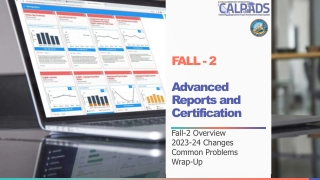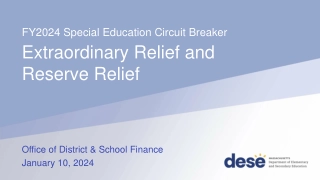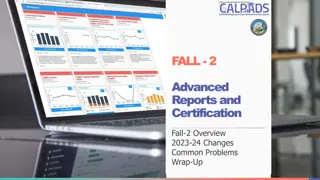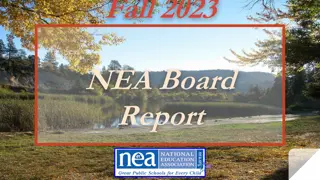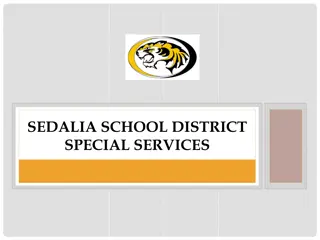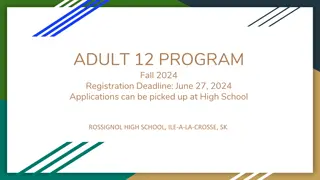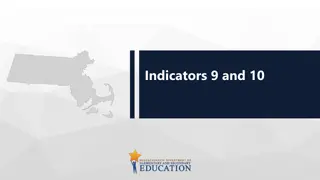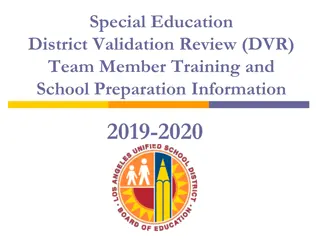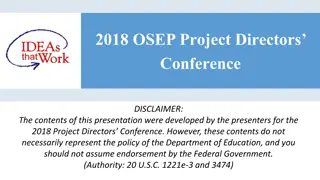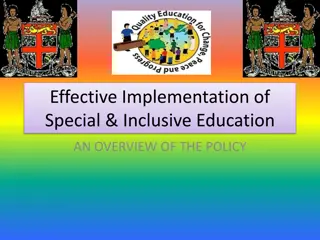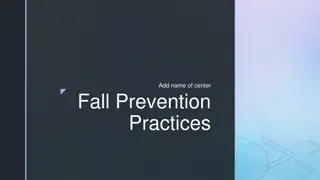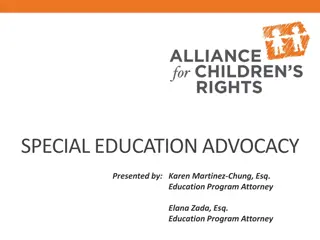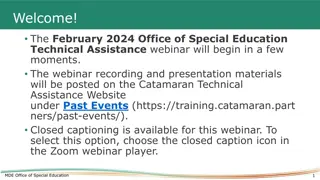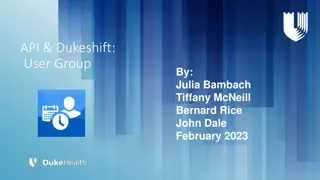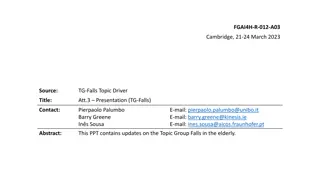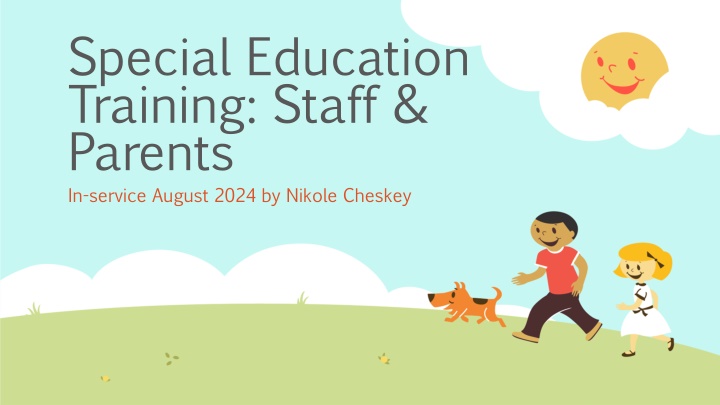
Special Education Training for Staff and Parents: August 2024 by Nikole Cheskey
Explore essential topics covered in the Special Education Training for staff and parents in August 2024 by Nikole Cheskey. Discover insights into Federal Laws, Disability categories, IEPs, and more to support students with disabilities effectively.
Download Presentation

Please find below an Image/Link to download the presentation.
The content on the website is provided AS IS for your information and personal use only. It may not be sold, licensed, or shared on other websites without obtaining consent from the author. If you encounter any issues during the download, it is possible that the publisher has removed the file from their server.
You are allowed to download the files provided on this website for personal or commercial use, subject to the condition that they are used lawfully. All files are the property of their respective owners.
The content on the website is provided AS IS for your information and personal use only. It may not be sold, licensed, or shared on other websites without obtaining consent from the author.
E N D
Presentation Transcript
Special Education Training: Staff & Parents In-service August 2024 by Nikole Cheskey
Welcome Back! Topics to cover today Federal Laws: Individuals with Disabilities Act of 2004 Child Find, Section 504 of the Rehabilitation Act & The Elementary and Secondary Education Act (ESEA) reauthorized as Every Student Succeeds Act (ESSA). Identify South Dakota Disability categories Define Individual Education Plans (IEPs) and membership roles for IEP meetings Questions and Answers
Individual with Disabilities Education Act (IDEA) and Section 504 Federal Laws that help protect the rights of students with disabilities.
300.111 Child Find (1) The State must have in effect policies and procedures to ensure that (4) If a State does not adopt the term developmental delay, an LEA may not independently use that term as a basis for establishing a child s eligibility under this part. (i) All children with disabilities residing in the State, including children with disabilities who are homeless children or are wards of the State, and children with disabilities attending private schools, regardless of the severity of their disability, and who are in need of special education and related services, are identified, located, and evaluated; and (c) Other children in child find. Child find also must include (ii) A practical method is developed and implemented to determine which children are currently receiving needed special education and related services. (1) Children who are suspected of being a child with a disability under 300.8 and in need of special education, even though they are advancing from grade to grade; and (b) Use of term developmental delay. The following provisions apply with respect to implementing the child find requirements of this section: (2) Highly mobile children, including migrant children. (1) A State that adopts a definition of developmental delay under 300.8(b) determines whether the term applies to children aged three through nine, or to a subset of that age range (e.g., ages three through five). (d) Construction. Nothing in the Act requires that children be classified by their disability so long as each child who has a disability that is listed in 300.8 and who, by reason of that disability, needs special education and related services is regarded as a child with a disability under Part B of the Act. (2) A State may not require an LEA to adopt and use the term developmental delay for any children within its jurisdiction. (3) If an LEA uses the term developmental delay for children described in 300.8(b), the LEA must conform to both the State s definition of that term and to the age range that has been adopted by the State. US Department of Education online https://sites.ed.gov/idea/regs/b/b/300.111
At a glance Child Find Education Act. The purpose of the law is to serve the education needs of kids with disabilities Child Find is part of the federal Individuals with Disabilities Schools have a big responsibility they must identify, locate, and evaluate any kids who need special education. This is called Child Find. Looking for and finding these kids is an important first step toward getting them the help they need to thrive in school. When a school knows, or thinks a child could have a disability, it must evaluate the child. Child Find applies to kids from birth to age 21. It can cover kids with learning and thinking differences, developmental delays, and other conditions.
IDEA: All students eligible under IDEA are also eligible for Section 504 504: Not all students who are eligible for section 504 are also eligible for IDEA Channing Bete Company Understanding IDEA and Section 504 A guide for parents of children with disabilities. 2022 Edition
IDEA and Section 504 IDEA provides federal guidelines and funding to states (BIE) to help guarantee special education and related services to eligible students ages 3 to 21. (under 3 may be eligible for early intervention services) 504 prohibits discrimination against any person with a disability by any federally funded agency or organization. It requires states to provide programs for eligible students with disabilities that are equal to those for students without disabilities. There is no age requirement for 504. Parental consent required Parental consent recommended Requires and Individual Education Plan (IEP) outlining services that may help a student benefit from special education Requires a plan describing placement and services. Services for ALL students be equal. Federal funds provided to schools to help serve eligible children No funds provided Channing Bete Company Understanding IDEA and Section 504 A guide for parents of children with disabilities. 2022 Edition
Who can get services under these laws? IDEA covers students who need special education and related services because they have a disability in one or more these categories 500-Deaf Blindness 505 505- -Emotional Disability Emotional Disability 510 510- -Cognitive Disability Cognitive Disability Bold category is the majority of disabilities identified at the PILC 515-Hearing Loss 525 525- -Specific Learning Disability Specific Learning Disability The Disability categories can be found at 535-Orthopedic Impairment 540-Vision Loss https://doe.sd.gov/sped/IEP.aspx https://doe.sd.gov/sped/IEP.aspx 545-Deafness in the Referral/Eligibility table. 550-Speech/Language Impairment 555 555- -Other Health Impaired Other Health Impaired 560-Austim Spectrum Disorder 565-Tramatic Brain Injury 570-Developmental Delay
Section 504 covers any person who: Has a physical or mental impairment that limits one or more major life activity A major life activity major life activity under 504 includes: Breathing Has a record of such impairment (doctor s diagnosis) caring for oneself Concentrating Is regarded as having such an impairment Eating Hearing Learning Performing manual tasks Channing Bete Company Understanding IDEA and Section 504 A guide for parents of children with disabilities. 2022 Edition Seeing, speaking, walking and working
IDEA & Section 504 aim to help students with disabilities reach their potential. They involve parent/guardians in their education. Teamwork is an important part of a successful plan They can improve opportunities for higher education, future employment and achieving independence in adulthood.
If you or a parent or guardian think a child is If you or a parent or guardian think a child is eligible please reach out to the school. eligible please reach out to the school. -A potential evaluation of child s history including medical records will be conducted -Observations from professionals, yourselves, teachers and anyone who works with the child could be done -Possible referral for special tests to measure the child s development, abilities, intelligence, behavior and academic progress will potentially be completed
. Feed Key Learning Disability Statistics: Key Learning Disability Statistics: At least 1 in every 59 children has one or several learning disabilities. 1 in 5 children in the U.S. have learning and thinking differences such as ADHD or Dyslexia. As of 2021, 2.8 million 2.8 million kids are actively getting services involving special education. kids are actively getting services involving special education. 41 Learning Disabilities Statistics & Prevalence (2023) https://www.crossrivertherapy.com learning-disabilities... In 2022 23, the number of students ages 3 21 who received special education and/or related services under the Individuals with Disabilities Education Act (IDEA) was 7.5 million, or the equivalent of 15 percent of all public school students million, or the equivalent of 15 percent of all public school students. Among students receiving special education and/or related services, the most common category of disability was specific learning disabilities (32 percent). https://nces.ed.gov/programs/coe/indicator/cgg/students-with-disabilities 7.5 At the conclusion of SY2034-24 the PILC had a 40% special education rate.
Some of the main principles under IDEA: A FREE, APPROPRIATE PUBLIC EDUCATION (FAPE)- Eligible students receive special education & related services at no cost to parents. These services must meet state standards. EVALUATION & PLACEMENT PROCEDURES- A parent s consent is generally required before an evaluation or placement can take place. A reevaluation takes place at least every 3 years, unless the parents or local education agency agree to postpone it. LEAST RESTRICTIVE ENVIRONMENT (LRE) FOR LEARNING- As much as possible, eligible students may attend classes in regular classrooms and take part in school activities with children who do not have disabilities. PROCEDURAL SAFEGUARDS- Schools must give written notice to parents/guardians before initiating or changing (or refusing to change) a student s *Identification *Evaluation *Educational Placement (such as to receive regular or special education). Channing Bete Company Understanding IDEA and Section 504 A guide for parents of children with disabilities. 2022 Edition
Section 504 shares many of the same principles of IDEA, with only a few differences FAPE- As with IDEA, eligible students have the right under Section 504 to an education that is equal to that provided to students without disabilities. Special Education and Related services to meet this requirement are provided at no cost to parents. EVALUATION AND PLACEMENT PROCEDURE- An evaluation is required before placement changes or accommodations can be made. Periodic reevaluation is required, but the frequency is not specified. As with IDEA, parental consent is required before the initial evaluation THE LEAST RESTRICTIVE ENVIRONMENT- (LRE) Same policy as IDEA PROCEDURAL SAFEGUARDS- Parents must be told about any identification, evaluation and/or placement before any significant changes are made REASONABLE ACCOMMODATIONS- Students must receive opportunities that are comparable to those provided to children w/out disabilities. This includes academic and non-academic school programs. Channing Bete Company Understanding IDEA and Section 504 A guide for parents of children with disabilities. 2022 Edition
Elementary and Secondary Education Act (ESEA): The Elementary and Secondary Education Act (ESEA) was signed into law in 1965 by President Lyndon Baines Johnson, who believed that "full educational opportunity" should be "our first national goal." From its inception, ESEA was a civil rights law. ESEA offered new grants to districts serving low-income students, federal grants for textbooks and library books, funding for special education centers, and scholarships for low-income college students. Additionally, the law provided federal grants to state educational agencies to improve the quality of elementary and secondary education.
Every Student Succeeds Act Every Student Succeeds Act (ESSA) reauthorization of ESEA President Obama signs the Every Student Succeeds Act into law on December 10, 2015. ESSA includes provisions that will help to ensure success for students and schools. The law: Advances equity by upholding critical protections for America's disadvantaged and high-need students. Requires for the first time that all students in America be taught to high academic standards that will prepare them to succeed in college and careers. Ensures that vital information is provided to educators, families, students, and communities through annual statewide assessments that measure students' progress toward those high standards. Helps to support and grow local innovations including evidence-based and place-based interventions developed by local leaders and educators consistent with our Investing in Innovation and Promise Neighborhoods Sustains and expands this administration's historic investments in increasing access to high- quality preschool. Maintains an expectation that there will be accountability and action to effect positive change in our lowest-performing schools, where groups of students are not making progress, and where graduation rates are low over extended periods of time. US Department of Education online https://www.ed.gov/essa?src=rn
IEP must haves: IEP must haves: -Present Levels of performance -Measurable annual goals -How goals will be measured -Statement of special education and related services -No later than 16, IEP must address post secondary goals -All members must be present at IEP meeting -If agreement to amend or modify the IEP, it can be done w/o a formal meeting IEP meetings, mediation & resolution meetings can be done via conference call. Rodriguez and Murawski, 2022
Trainings Available to PILC staff and parents Vector Solutions Exceptional Child platform https://pierreilc-sd.exceptionalchild.com/login must check k12 email- Trainings are sent to your email. If you do not have a k12 email let your supervisor know Direct STEP: https://dc-bie2020-ds.lrp.com/login/index.php3 (create new account) Special Education Connection: www.specialedconnection.com (Username: bieedu Password: educate)
Resources: Channing Bete. Your Guide to Special Education & Your Child. 2016 Edition Channing Bete. Understanding IDEA and Section 504. A guide for parents of children with disabilities. 2022 Edition. Disabilities Rights Education & Defense Fund, DREDF. Accessed 2023, May 22. <https://dredf.org> LD Online. Accessed 2022, June 14. <https://ldoline.org> Rodriguez , J. A., & Murawski, W. W. (2022). Special Education Law and Policy: From Foundation to Application. San Diego, California: Plural Publishing. South Dakota Department of Education Eligibility Guide. (Revised AUGUST 2016). Accessed 2023, May 22 <https://doe.sd.gov> National Center for Educational Statistics, August 2023 https://nces.ed.gov/programs/coe/indicator/cgg/students-with-disabilities Understood Accessed 2024, August 6 https://www.understood.org/en/articles/child-find-what-it-is-and-how-it-works Thank you for your time! Any questions? Nikole Cheskey- 224-8661 X166 nikole.cheskey@k12.sd.us


